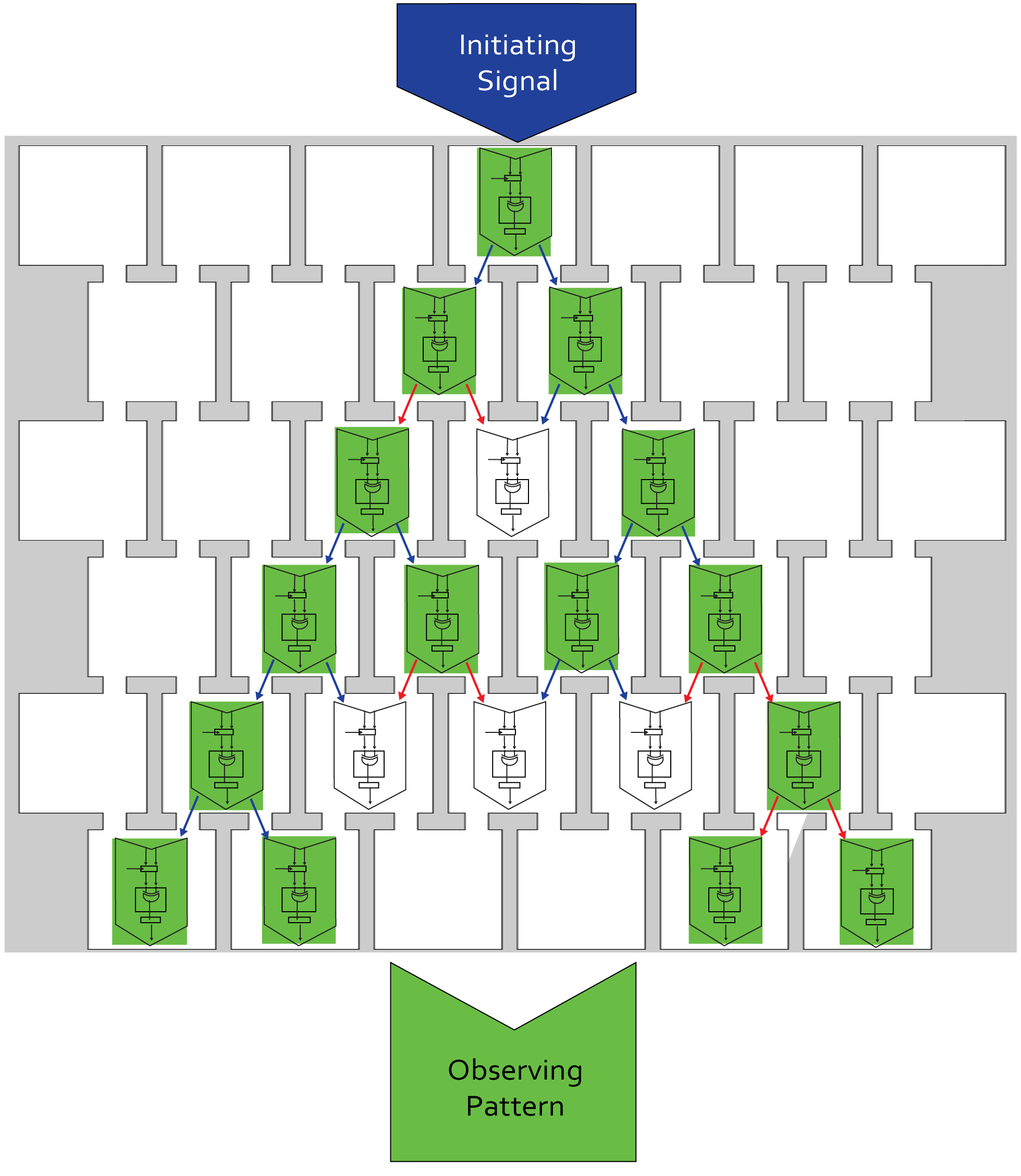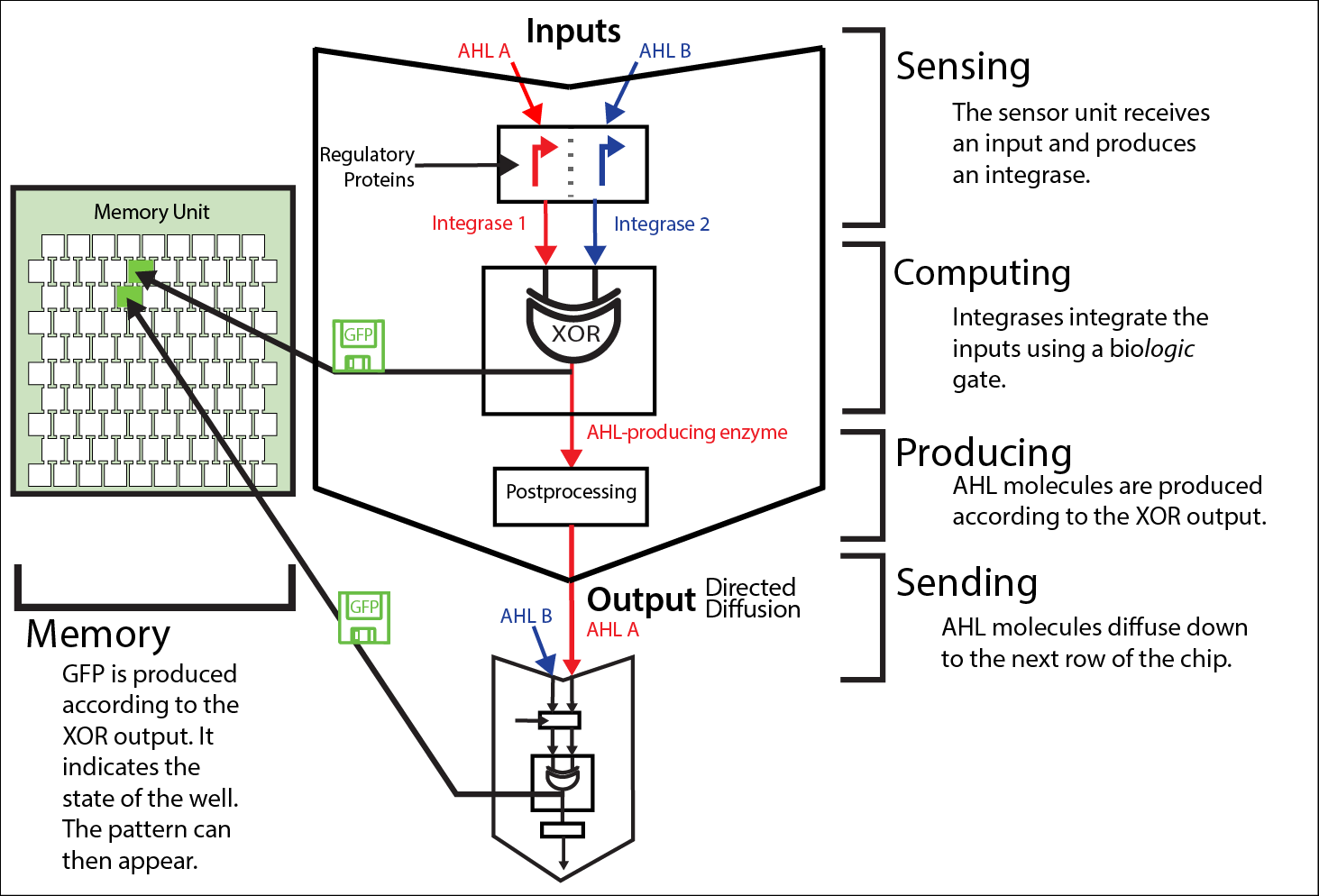Team:ETH Zurich/project/infopro
From 2014.igem.org
(→Track: Information Processing) |
(→Pattern Emergence) |
||
| Line 10: | Line 10: | ||
[https://2014.igem.org/Tracks/Information_Processing ''«Information Processing in iGEM covers a diverse range of projects. IP teams are not trying to solve a real world problem with practical applications, but to tackle an interesting problem that might otherwise not attract attention. Teams enter this track if they are attempting projects such as building elements of a biological computer, creating a game using biology or working on a signal processing challenges. Engineering ways to make biological systems perform computation is one of the core goals of synthetic biology. We generally work at the DNA level, engineering systems to function using BioBricks. In most biological systems, protein-protein interactions are where the majority of processing takes place. Being able to design proteins to accomplish computation would allow for systems to function on a much faster timescale than the current transcription-translation paradigm»'' (iGEM mainpage)] | [https://2014.igem.org/Tracks/Information_Processing ''«Information Processing in iGEM covers a diverse range of projects. IP teams are not trying to solve a real world problem with practical applications, but to tackle an interesting problem that might otherwise not attract attention. Teams enter this track if they are attempting projects such as building elements of a biological computer, creating a game using biology or working on a signal processing challenges. Engineering ways to make biological systems perform computation is one of the core goals of synthetic biology. We generally work at the DNA level, engineering systems to function using BioBricks. In most biological systems, protein-protein interactions are where the majority of processing takes place. Being able to design proteins to accomplish computation would allow for systems to function on a much faster timescale than the current transcription-translation paradigm»'' (iGEM mainpage)] | ||
| - | === Pattern | + | === Why we chose this track === |
| + | |||
| + | |||
| + | |||
| + | |||
| + | === The goal: Pattern emergence === | ||
We implement a cellular automaton in bacterial colonies. Each bacterial colony is a core, computing an XOR gate. A sensor device detects the inputs, HSL molecules. Then, the cell integrates the signal through a logic gate, performed by proteins, the serine integrases. A necessary post processing step generates the production of HSL molecules. Meanwhile, GFP, a visual read out, longlastingly indicates the state of the well. The produced signal then propagates in a directive fashion through a millifluidic chip. This iterative process faces the challenges of leakiness, cross-talk, protein-level computation and diffusion. | We implement a cellular automaton in bacterial colonies. Each bacterial colony is a core, computing an XOR gate. A sensor device detects the inputs, HSL molecules. Then, the cell integrates the signal through a logic gate, performed by proteins, the serine integrases. A necessary post processing step generates the production of HSL molecules. Meanwhile, GFP, a visual read out, longlastingly indicates the state of the well. The produced signal then propagates in a directive fashion through a millifluidic chip. This iterative process faces the challenges of leakiness, cross-talk, protein-level computation and diffusion. | ||
<br/> | <br/> | ||
Revision as of 01:49, 18 October 2014
Information Processing
Information Processing
About the track
Why we chose this track
The goal: Pattern emergence
We implement a cellular automaton in bacterial colonies. Each bacterial colony is a core, computing an XOR gate. A sensor device detects the inputs, HSL molecules. Then, the cell integrates the signal through a logic gate, performed by proteins, the serine integrases. A necessary post processing step generates the production of HSL molecules. Meanwhile, GFP, a visual read out, longlastingly indicates the state of the well. The produced signal then propagates in a directive fashion through a millifluidic chip. This iterative process faces the challenges of leakiness, cross-talk, protein-level computation and diffusion.
Sensing
Diffused HSL molecules are identified via quorum sensing machinery. The transfer function between concentration of sensed HSL to promoter activation deviates from the ideal one due to leakiness and crosstalk between HSL molecules, regulatory proteins and promoters (we characterized it for [http://parts.igem.org/Part:BBa_R0062 Lux promoter (BBa_R0062)], [http://parts.igem.org/Part:BBa_R0079 Las promoter (BBa_R0079)] and [http://parts.igem.org/Part:BBa_R0071 Rhl promoter (BBa_R0071)]). To limit the risk of error propagation, we implemented a [http://parts.igem.org/Part:BBa_K1541000 riboregulated system].
Computing
Integrases compute an XOR logic gate via single switching or double switching of a terminator. Their behavior depends on a set of parameters.
Producing
To propagate the computation results, the output has to be translated again into a quorum sensing molecule. Therefore a synthase is expressed to produce a new AHL signal.
Memorising
Alongside the AHL synthase, GFP is produced according to the XOR output. Th fluorescent protein acts both as long term memory for the colony state and as visual signal, storing and showing the progressive pattern formation.
Sending
The produced AHL diffuses through the channels to the rows below, becoming the input of the following layer. The speed of this directed diffusion determines the time needed from the pattern to emerge. You can find out more information about diffusion and chip design on our modeling page, our experimental results page and our chip page.

 "
"














